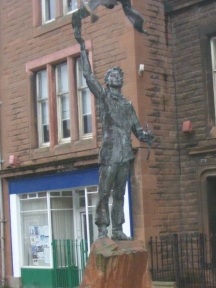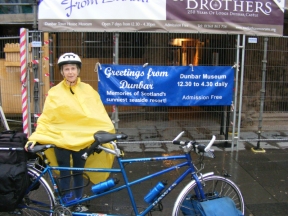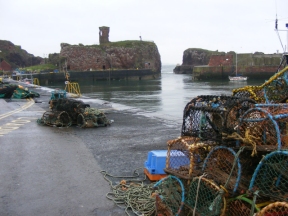Previous Chapter
Sunday 1stJune 2008
Burnmouth to Dunbar
The forecast for the day was not good with rain due to spread northwards by the afternoon. We left Burnmouth on the lane leading to Eyemouth, where we hoped to buy provisions for lunch. Soon after the harbour, where the fishermen were busy unloading their catch, we found the local Co-op where we stocked up. Back to the lanes again when we left Eyemouth following the valley of the river Ale Water and gradually gaining height as we made our way towards Cockburnspath where a Public House was marked on the map. A cup of tea perhaps or even a Sunday lunch maybe if we took our time. As we descended the hill into the village we noticed a new noise from the tandem – a clicking from the back wheel as we freewheeled. Not what we wanted to hear on only the second day of our travels. And to make matters worse there was no sign of the public house when we got into the village – enquiries in the local shop confirmed that it no longer existed.
It was only mid morning and Dunbar was only a hour away – there was a couple of miles of A1 to put up with but on the whole the route used the lanes running more or less parallel to the main road. We reached Dunbar just after the rain started and after a quick tour round the town settled on a pub for a Sunday Roast beef dinner – and the beef was excellent.
So what could we do for the afternoon – the waitress in the bar had no solutions - “Dunbar is dead on a Sunday Afternoon. You could possibly go to the John Muir Museum if it’s open”.  This museum is dedicated to the botanist, conservationist and geologist, John Muir, who was born in Dunbar in 1838. His father was very strict and only allowed him to read the Bible – other books were not allowed. The family emigrated to Wisconsin, America when John was 11 years old – life was tough with very long working hours. Eventually his father allowed him to read books, which he borrowed from his neighbours, on condition that it did not affect his work. So John rose at 1 in the morning to read and to pursue his passion for invention – clocks, thermometers, etc. At the age of 22 he demonstrated some of these at the Wisconsin State fair and soon after this enrolled at the University where he studied chemistry, botany and geology. At the age of 30 he made his way to San Francisco but soon left for the wilderness of Yosemite where he studied the flowers, creatures and trees. He married in 1880 at the age of 42. Encouraged by his wife he began to write about his passion for protecting the environment and it was through his writing that Yosemite became a National Park. He was very influential even convincing President Roosevelt of the need to protect the environment. A lovely little museum – full of interesting information.
This museum is dedicated to the botanist, conservationist and geologist, John Muir, who was born in Dunbar in 1838. His father was very strict and only allowed him to read the Bible – other books were not allowed. The family emigrated to Wisconsin, America when John was 11 years old – life was tough with very long working hours. Eventually his father allowed him to read books, which he borrowed from his neighbours, on condition that it did not affect his work. So John rose at 1 in the morning to read and to pursue his passion for invention – clocks, thermometers, etc. At the age of 22 he demonstrated some of these at the Wisconsin State fair and soon after this enrolled at the University where he studied chemistry, botany and geology. At the age of 30 he made his way to San Francisco but soon left for the wilderness of Yosemite where he studied the flowers, creatures and trees. He married in 1880 at the age of 42. Encouraged by his wife he began to write about his passion for protecting the environment and it was through his writing that Yosemite became a National Park. He was very influential even convincing President Roosevelt of the need to protect the environment. A lovely little museum – full of interesting information.
 By now it was mid afternoon – where to go next? There was another small museum about Dunbar just down the road which occupied us for a while. Outside on the railings was a notice – Dunbar the Sunniest town in Britain – and just alongside a statue of John Muir as a young man. After a quick look in the museum and at the ruins of Dunbar castle
By now it was mid afternoon – where to go next? There was another small museum about Dunbar just down the road which occupied us for a while. Outside on the railings was a notice – Dunbar the Sunniest town in Britain – and just alongside a statue of John Muir as a young man. After a quick look in the museum and at the ruins of Dunbar castle  and the gulls nesting in it’s walls down by the harbour, we decided to try and ring the B&B to seek early shelter from the rain. No reply. So when we arrived hopefully at the house 15 mins later we were greeted by a notice on the door saying “Gone out. Back in half an hour”. The apple tree in the garden gave us some protection from the rain. 20 mins later the family arrived home and we were quickly made to feel at home with our wet clothes drying in front of the Aga. On telling them about the problems with the Tandem we were informed that there was a bike shop in the town – so our first port of call on Monday morning would be the shop. We could leave our bags at the B&B while the bike was sorted.
and the gulls nesting in it’s walls down by the harbour, we decided to try and ring the B&B to seek early shelter from the rain. No reply. So when we arrived hopefully at the house 15 mins later we were greeted by a notice on the door saying “Gone out. Back in half an hour”. The apple tree in the garden gave us some protection from the rain. 20 mins later the family arrived home and we were quickly made to feel at home with our wet clothes drying in front of the Aga. On telling them about the problems with the Tandem we were informed that there was a bike shop in the town – so our first port of call on Monday morning would be the shop. We could leave our bags at the B&B while the bike was sorted.
Mileage today 30.6 miles. Total 40.6 miles.